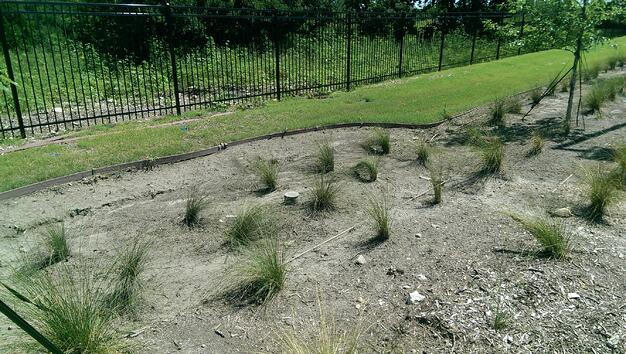I’ve worked for Construction EcoServices for the last two years and one thing I’ve learned is that something will always go wrong during construction. It doesn’t matter how good the design is, challenges will have to be conquered to reach the ultimate goal of a finished project. One of the most common challenges that occur for biofiltration systems is erosion. We faced a significant erosion problem after our team constructed 4 FocalPoint biofiltration systems on a project in Frisco, TX. A few heavy rain events is all it took for sediment to erode from the bioswale slopes and into the mulch layer.
 The benefit of using a high performance system, such as FocalPoint, is that it is more resilient to these common issues. The erosion issue didn’t go away and over a 6 month period the bioswale began to show the all too common signs of a clogging. In situations like this, blame can rest upon the shoulders of the contractor or designer. But this didn’t happen because of the performance-based specifications of the FocalPoint system. It requires the 1st year’s maintenance be provided by the installer, because this time period is when most problems occur. Instead of the designer or City getting a call from the landowner, Construction EcoServices sent our maintenance department to Frisco, TX to solve the issue before it became a problem. After 5 hours of a two-man crew working in the hot sun, the clogged mulch layer was removed and replaced with a new 3″ layer of shredded hardwood mulch.
The benefit of using a high performance system, such as FocalPoint, is that it is more resilient to these common issues. The erosion issue didn’t go away and over a 6 month period the bioswale began to show the all too common signs of a clogging. In situations like this, blame can rest upon the shoulders of the contractor or designer. But this didn’t happen because of the performance-based specifications of the FocalPoint system. It requires the 1st year’s maintenance be provided by the installer, because this time period is when most problems occur. Instead of the designer or City getting a call from the landowner, Construction EcoServices sent our maintenance department to Frisco, TX to solve the issue before it became a problem. After 5 hours of a two-man crew working in the hot sun, the clogged mulch layer was removed and replaced with a new 3″ layer of shredded hardwood mulch.
 Even though maintenance is straight forward and simple, it does require a trained eye to get the job done. Typically, most contractors would just add more mulch and call it a day. This doesn’t solve the problem because the mulch acts as pre-treatment for the engineered soil. It prevents silt and clay particles from choking off the voids in the sandy layer of drainage media. Just like an air filter in a car or house, it needs to be removed an replaced with a new one. During the removal of the mulch it takes trained personnel to recognize the difference between topsoil and engineered soil. If too much engineered soil is removed with the mulch, it can affect the performance of the system.
Even though maintenance is straight forward and simple, it does require a trained eye to get the job done. Typically, most contractors would just add more mulch and call it a day. This doesn’t solve the problem because the mulch acts as pre-treatment for the engineered soil. It prevents silt and clay particles from choking off the voids in the sandy layer of drainage media. Just like an air filter in a car or house, it needs to be removed an replaced with a new one. During the removal of the mulch it takes trained personnel to recognize the difference between topsoil and engineered soil. If too much engineered soil is removed with the mulch, it can affect the performance of the system.
I encourage all designers to specify a maintenance period for biofiltration or bioretention systems. This will decrease the inherent risk of these water quality systems and put the liability of performance on the contractor installing the system.




